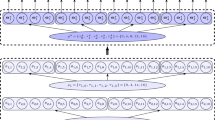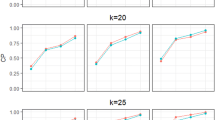Abstract
The existing PIN models impose a restriction on the number of possible intensity pairs. However, our investigation shows that the number of empirical intensity pairs is significantly more than the one these models assume, and this number changes daily. Therefore, we propose a new model which, by using the change-point detection technique, can adjust this number according to the data. The model also considers autocorrelation, which is lacking in the existing PIN models. In addition, we show that the proposed model can examine how public information transfers to individual stock price and quantify transfer delay.






Similar content being viewed by others
References
Aslan H, Easley D, Hvidkjaer S, O’Hara M (2011) Firm characteristics and informed trading: implications for asset pricing. J Empir Financ 18:782–801
Bai J, Perron P (2003) Computation and analysis of multiple structural change models. J Appl Economet 18:1–22
Chang C, Lin E (2014) On the determinants of basis spread for Taiwan index futures and the role of speculators. Rev Pac Basin Financ Mark Policies 17:1–30
Chang C, Lin E (2015) Cash-futures basis and the impact of market maturity, informed trading, and expiration effects. Int Rev Econ Financ 35:197–213
Chen T (2022) Delayed informed trades and opinion divergence: evidence from earnings releases. Int J Financ Econ 27:4556–4574
Du C, Kao CL, Kou SC (2016) Stepwise signal extraction via marginal likelihood. J Am Stat Assoc 111:314–330
Duarte J, Young L (2009) Why is PIN priced? J Financ Econ 91:119–138
Easley D, O’Hara M (2004) Information and the cost of capital. J Finance 59:1553–1583
Easley D, Kiefer N, O’Hara M, Paperman JB (1996) Liquidity, information and infrequently traded stocks. J Finance 51:1405–1436
Easley D, Hvidkjaer S, O’Hara M (2002) Is information risk a determinant of asset returns? J Finance 57:2185–2221
Easley D, Engle RF, O’Hara M, Wu L (2008) Time-varying arrival rates of informed and uninformed traders. J Financ Economet 6:171–207
Easley D, Hvidkjaer S, O’Hara M (2010) Factoring information into returns. J Financ Quant Anal 45:293–309
Easley D, López de Prado M, O’Hara M (2012) Flow toxicity and liquidity in a high frequency world. Rev Financ Stud 25:1457–1493
Frino A, Palumbo R, Rosati P (2022) Does information asymmetry predict audit fees? Account Finance 00:1–23
Gan Q, Wei WC, Johnstone D (2015) A faster estimation method for the probability of informed trading using hierarchical agglomerative clustering. Quant Finance 15:1805–1821
He G, Ren HM, Taffler R (2022) Do enhanced derivative disclosures work? An informational perspective. J Futur Mark 42:24–60
Kou SC (2008) Stochastic networks in nanoscale biophysics: modeling enzymatic reaction of a single protein. J Am Stat Assoc 103:961–975
Lai S, Ng L, Zhang B (2014) Does PIN affect equity prices around the world? J Financ Econ 114:178–195
Lin HW, Ke WC (2011) A computing bias in estimating the probability of informed trading. J Financ Mark 14:625–640
Lin E, Kao CL, Adityarini NS (2021) Data-driven tree structure for PIN models. Rev Quant Financ Acc 57:411–427
Lin E, Lee CF (2014) Application of Poisson mixtures in the estimation of probability of informed trading. In: Handbook of financial econometrics and statistics, vol 4, p 2601–2619, Springer
Mohanram P, Rajgopal S (2009) Is PIN priced risk? J Account Econ 47:226–243
Ruanaidh JJKO, Fitzgerald WJ (1996) Numerical Bayesian methods applied to signal processing. Springer, New York
Tay A, Ting C, Tse YK, Warachka M (2009) Using high-frequency transaction data to estimate the probability of informed trading. J Financ Economet 7:288–311
Yang Y, Zhang S (2012) An improved estimation method and empirical properties of the probability of informed trading. J Bank Finance 36:454–467
Funding
Funding was provided by Ministry of Science and Technology (Grant Number 107-2914-I-129-002-A1).
Author information
Authors and Affiliations
Corresponding author
Additional information
Publisher's Note
Springer Nature remains neutral with regard to jurisdictional claims in published maps and institutional affiliations.
Special thanks to Professors Massimo Massa and Carl R. Chen and the IFABS 2018 Chile Conference participants for their helpful comments and advice. All errors are our own.
Appendix. Preliminary empirical studies in the introduction
Appendix. Preliminary empirical studies in the introduction
In the introduction, we have motivated our studies by briefly presented that the empirical data contradicts what previous models assumed by having a considerably higher and diversified estimated number of mixture components. This is done by using the empirical data described in Sect. 3.3. For each day of each company, we assume the buy/sell order flows of that day follow the model as described in Sect. 3.1 with an unknown number of \(I\left(m\right)\), which is the number of parameter pairs, or equivalently, the number of components of the model. We then use the change-point detection algorithm discussed in Sect. 3.2 to estimate this number, and also the parameter pairs for each of these components.
For example, based on the data of Apple stock in 28/12/2012, the change-point detection algorithm estimates a total of 32 components, with the parameter pair of each component presenting as a dot in Fig.
6. We further summarize the estimated number of components for each single day of the Apple stock during the period, and present them through a histogram in Fig.
7. Both of the figures confirm the argument of assumption contradiction claimed in the introduction. The other companies show similar behaviors.
The figure presents the estimated pairs of \({(\uplambda }_{\mathrm{B},\mathrm{j}},{\uplambda }_{\mathrm{S},\mathrm{j}})\) for Apple stock on 28/12/2012 assuming that the buy/sell order flows follow a mixture of joint Poisson distributions with parameters (\({\uplambda }_{\mathrm{B},\mathrm{j}},{\uplambda }_{\mathrm{S},\mathrm{j}})\). The estimations are based on the algorithm provided by Du et al. (2016), which first estimated the number of components, J, and then estimated \({(\uplambda }_{\mathrm{B},\mathrm{j}},{\uplambda }_{\mathrm{S},\mathrm{j}})\) for \(1\le j\le J\). The scatter plot presents all such estimated pairs \({(\uplambda }_{\mathrm{B},\mathrm{j}},{\uplambda }_{\mathrm{S},\mathrm{j}})\).
The figure presents the distribution of the daily estimated J for Apple stock from 3/1/2003 to 28/12/2012 using the same algorithm as in Fig. 6.
Rights and permissions
Springer Nature or its licensor (e.g. a society or other partner) holds exclusive rights to this article under a publishing agreement with the author(s) or other rightsholder(s); author self-archiving of the accepted manuscript version of this article is solely governed by the terms of such publishing agreement and applicable law.
About this article
Cite this article
Kao, CL.M., Lin, E. A new PIN model with application of the change-point detection method. Rev Quant Finan Acc 61, 1513–1528 (2023). https://doi.org/10.1007/s11156-023-01194-9
Accepted:
Published:
Issue Date:
DOI: https://doi.org/10.1007/s11156-023-01194-9






